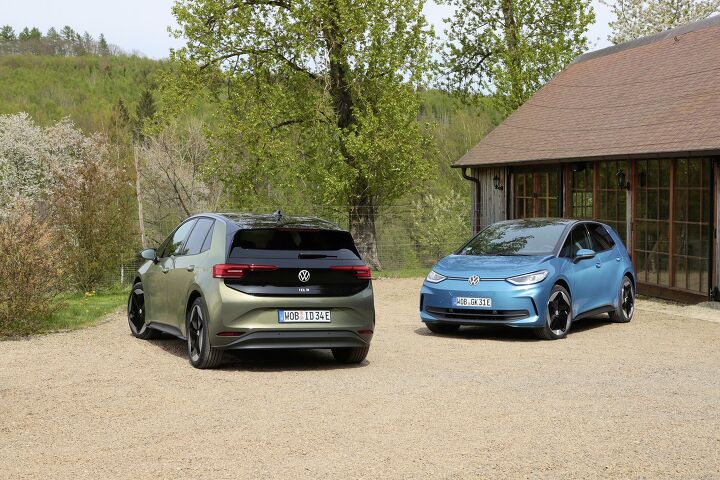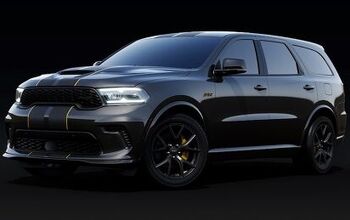Volkswagen Temporarily Cutting Production of European EVs

Volkswagen intends to temporarily limit production of the SEAT Cupra Born and its very own ID.3 EV in October. The company has cited market forces as the cause, noting that its Zwickau and Dresden plants in Germany would be throttled down for a couple of weeks.
According to Reuters, regional demand for both models has declined as Chinese EVs have started to become commonplace in Europe. Pricing has also become an issue due to sizable inflation and some scaling back of the EU’s electric vehicle incentives. However, it must be said that the ID.3 technically is a Chinese-made EV.
While most European allocations stem from Germany, examples from the Chinese market are the result of the joint partnership between Volkswagen Group and SAIC Motor and are assembled domestically.
Vehicle production will be scaled back from October 2nd through the 13th at Volkswagen's Zwickau plant (just in time for Oktoberfest) and from October 2nd to the 16th at the Dresden facility.
Reuters reported that the company declined to comment on the number of employees that will be affected. Earlier in the month, VW said that it would not extend the fixed-term contracts of 269 employees at its all-electric Zwickau plant — perhaps indicating that there is more going on here than meets the eye.
Meanwhile, demand seems to be increasing on the ID.4 manufactured in Chattanooga, Tennessee (in addition to the ID.3 plans located in Germany and China) seems to be improving. However, the relevant reporting often fails to mention how an uptick in model volume may be the result of a slow launch undermined by production issues.
It’s easy to claim something is enjoying a massive increase in sales when it’s a novel model starting from a modest production run.
In truth, Volkswagen’s EVs aren’t doing so well on the global stage. Both the ID.3 and ID.4 have undergone significant price cuts in China. For example, the ID.4 launched with a Chinese MSRP of 193,900 yuan (roughly $27,000 USD) in 2021. After repeat markdowns, it now costs just 145,900 yuan (about $20,000 USD) while the U.S. version retails somewhere around $39,000.
The ID.3 has been subjected to similar price cuts and now starts at around $16,500 (translated into USD) in China. However, examples sold in the United Kingdom are priced closer to $44,000 (likewise converted into USD).
This wouldn’t be an issue if Western consumers had an endless supply of money or if Chinese markets didn’t have so much cheap competition. Compared to other segments, EV volumes remain relatively small and tend to be focused upmarket where people can splurge on a luxurious local runabout. That’s not good news for the aforementioned Volkswagen products.
The company seems to have found itself in a bit of a pickle. But we cannot say how things will play out in the long term. Price cuts in China coincided with a 300-percent increase in regional sales for the ID.3 between June and July of 2023 and we’ve seen American ID.4 sales progress steadily as production improves.
Meanwhile, VW has continued experiencing shrinking volumes in Europe and China over the last several years. A complete disaster managed to be averted by the company managing to improve vehicle margins (something every automaker has been trying to do of late). But those days may be ending as even more customers are priced out of the new vehicle market. The synergies afforded by economies of scale tend to lose momentum as volumes decline and there are very few automakers that will be able to continue selling automobiles with exceptionally broad margins.
[Image: Volkswagen Group]
Become a TTAC insider. Get the latest news, features, TTAC takes, and everything else that gets to the truth about cars first by subscribing to our newsletter.

A staunch consumer advocate tracking industry trends and regulation. Before joining TTAC, Matt spent a decade working for marketing and research firms based in NYC. Clients included several of the world’s largest automakers, global tire brands, and aftermarket part suppliers. Dissatisfied with the corporate world and resentful of having to wear suits everyday, he pivoted to writing about cars. Since then, that man has become an ardent supporter of the right-to-repair movement, been interviewed on the auto industry by national radio broadcasts, driven more rental cars than anyone ever should, participated in amateur rallying events, and received the requisite minimum training as sanctioned by the SCCA. Handy with a wrench, Matt grew up surrounded by Detroit auto workers and managed to get a pizza delivery job before he was legally eligible. He later found himself driving box trucks through Manhattan, guaranteeing future sympathy for actual truckers. He continues to conduct research pertaining to the automotive sector as an independent contractor and has since moved back to his native Michigan, closer to where the cars are born. A contrarian, Matt claims to prefer understeer — stating that front and all-wheel drive vehicles cater best to his driving style.
More by Matt Posky
Latest Car Reviews
Read moreLatest Product Reviews
Read moreRecent Comments
- Redapple2 Raise the gas tax ~~ $2-3 /gallon -slowly- over the next 4-6 yrs. This will have 10X the pollution VS compulsory BEVs. Some one should write a story on this.
- 1995 SC If they are bending over the company who's name was on the building, I shudder to think how bad the customers were getting it there.
- SCE to AUX Sounds like recalibrated sensors are needed.
- SCE to AUX "Unfortunately, this has left many with product lineups overloaded with models loads of households can no longer afford."So what - as long as enough households can afford them, the mfrs don't need to care if everyone can afford them.The rest of this article is the usual omnibus rant about everything wrong in the auto industry right now - dealers, data spying, prices, EV challenges, regulation, etc.As for road taxes - the government(s) need to look in the mirror. Rising CAFE rules have eroded pump taxes for decades, and the Federal gas tax hasn't changed since 1993. PA (my state) with the highest gas tax in the US, still has some of the worst roads thanks to road quantity, geography, and weather.The tax should be: (GVWR x annual miles), so that everyone pays. Determining your annual mileage isn't hard to do. This would also incentive people to buy smaller/lighter vehicles.
- Wjtinfwb No car ever looked more different and less desirable than the Supra L. Where the Supra with the flares, big wheels and the wing looked aggressive, robust, sporting but upmarket and expensive, the L looked, sad. basically a stretched Celica with a 6 cylinder, it looked like it and was quickly forgotten in the marketplace. This one looks like its lived a rough life, probably will run forever but that doesn't mean you'll want it to.


































Comments
Join the conversation
If these companies really believe they have to drop ICE and go full EV to save the planet, perhaps the should stop charging double the Chinese price to help the Earth and it's inhabitants out, I'm told before it's too late.
Duh.